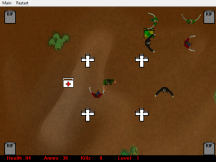
In a previous post, DIY VR Part 1, we took a look at apps that allowed a user to stream PC games to a smartphone in stereoscopic 3D, which could then be used with a Google Cardboard compatible headset to experience VR.
This worked well, however the apps examined in the previous post did not support or were not optimized for games specifically designed for SteamVR. For SteamVR to start up a compatible HMD (Head Mounted Display, like Oculus Rift or HTC Vive) needs to be detected, something the apps covered previously did not support, with the exception of TrinusVR which does support this, however it does not support USB tethering with iOS which has a significant negative effect on the experience.
Today we will look at an app that does fully supports this functionality, iVRy.
iVRy is an iOS app that allows SteamVR games to be streamed to an iPhone, and as with the previously mentioned apps, utilizes the phone’s gyroscope and accelerometers for head tracking and movement.
iVRy comprises of a app that is installed on your iPhone and a SteamVR HMD driver to be installed alongside SteamVR on your PC.
The iPhone is then connected to the PC either via Wi-Fi or USB (preferably USB as the results are greatly improved). The next step is to start the iVRy app on the phone and then lastly launch
SteamVR (which will detect the phone as a compatible HMD) and you are up and running.
The app has various settings to optimally configure your VR experience, such as lens distortion correction and field of view settings, with a large list of Google Cardboard Compatible Headsets preconfigured for ease of use.
Another feature of the app is that it auto adjusts image quality to ensure a high frame rates, reducing VR sickness.
iVRy supports a lot of SteamVR titles, working with any game that does not require motion controls, so any game that supports a traditional controller should work. Saying this a controller is pretty much required and any Steam compatible controller will work.
iVRy has a free trial version that does not limit play time, but reduces color saturation after 5 minutes of play time, making the image appear in shades of grey. To unlock the full premium version of iVRy costs $6.99, which removes the 5 minute limitation.
If you are an Android user a similar app is available called VRidge by RiftCat, which costs $14.99. It does however offer a great deal more functionality, thus the higher price.
Now on a related topic, I recently had the opportunity to play around with a HTC Vive at the Microsoft Store at NorthPark Center in Dallas Texas, and it was an amazing experience. I played through a series of experiences, starting with a tutorial based on the game Portal and then flowing into The Blu, AudioShield and finally Space Pirate Trainer. The experience was extremely immersive and I got goose bumps, it was truly mind blowing. The motion controls and room tracking of the Vive work extremely well and helps greatly with the immersion. If you ever have an opportunity to use a HTC Vive I would highly recommend it.
While I was in Dallas I also went to see some interesting sights, like the Oculus VR Dallas offices, where John Carmack is based.
Now for a quick update on the DIY VR Headset Version 2. I have acquired the parts for the new headset, including two 1920×1280 (60 Hz) 3.5inch (89mm) displays (one for each eye) and a Leap Motion, which I will use to implement motion controls. I have decided for the version 2 to use two smaller independent displays mounted in portrait mode (similar to what is done in the HTC Vive and Oculus Rift, post Development Kit 1 which used one screen).
I will also look at using iVRy with the Leap Motion to get motion controls working in Steam VR. So watch this space, some exciting things are coming.




















